教师资格证考试高中英语教案模板
高中英语教资教案设计全套4篇
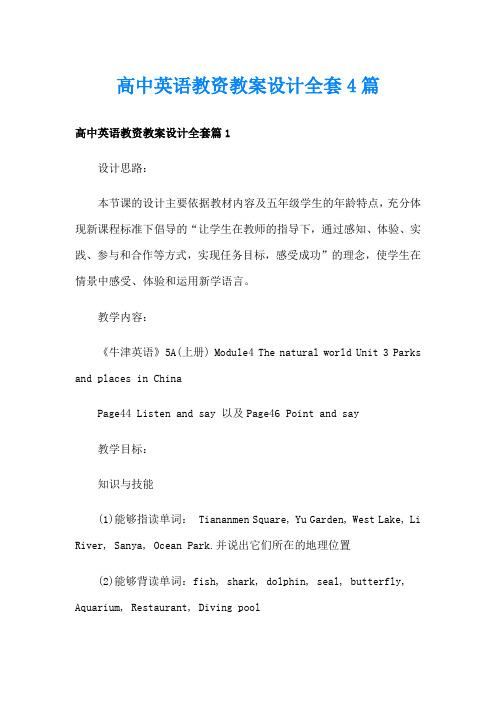
高中英语教资教案设计全套4篇高中英语教资教案设计全套篇1设计思路:本节课的设计主要依据教材内容及五年级学生的年龄特点,充分体现新课程标准下倡导的“让学生在教师的指导下,通过感知、体验、实践、参与和合作等方式,实现任务目标,感受成功”的理念,使学生在情景中感受、体验和运用新学语言。
教学内容:《牛津英语》5A(上册) Module4 The natural world Unit 3 Parks and places in ChinaPage44 Listen and say 以及Page46 Point and say教学目标:知识与技能(1)能够指读单词: Tiananmen Square, Yu Garden, West Lake, Li River, Sanya, Ocean Park.并说出它们所在的地理位置(2)能够背读单词:fish, shark, dolphin, seal, butterfly, Aquarium, Restaurant, Diving pool(3)能够使用句型:Can we see…? Yes, let’s go to…。
We can see…there.(4)能够用简单的句型描述自己熟悉的城市或旅游景点。
过程与方法学生通过参与,感知,体验和小组合作来主动获取知识并运用于实践中。
情感态度(1)通过对自己家乡和祖国风景名胜的了解,激发学生热爱祖国热爱家乡的情感。
(2)在做小导游的游戏活动中培养学生的文化意识和自信品质。
教学重点:能够听、说、认、读单词fish, shark, dolphin, seal, butterfly 并运用句型:Can we see…? Yes, let’s go to…。
We can see…there.教学难点:a : 单词Aquarium、Restaurant的读音b: 用英文介绍自己最熟悉或感兴趣的城市(名胜),并简单用形容词和介词短语来描述这个城市(名胜)的特征,方位,地理位置,代表建筑等。
教师资格证考试高中英语教案模板
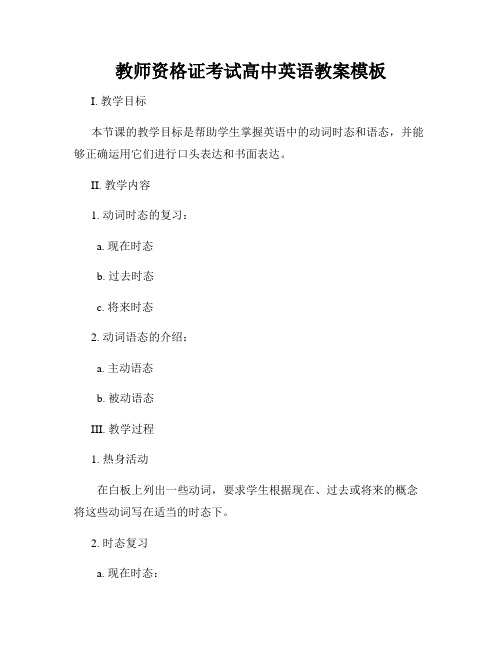
教师资格证考试高中英语教案模板I. 教学目标本节课的教学目标是帮助学生掌握英语中的动词时态和语态,并能够正确运用它们进行口头表达和书面表达。
II. 教学内容1. 动词时态的复习:a. 现在时态b. 过去时态c. 将来时态2. 动词语态的介绍:a. 主动语态b. 被动语态III. 教学过程1. 热身活动在白板上列出一些动词,要求学生根据现在、过去或将来的概念将这些动词写在适当的时态下。
2. 时态复习a. 现在时态:- 根据给定的句子填写正确的动词形式。
- 与学生进行口语交流,要求他们用现在时态回答一系列问题。
b. 过去时态:- 给学生提供一些事件,要求他们将这些事件写成过去时态的句子。
- 与学生进行对话练习,要求他们用过去时态回答一系列问题。
c. 将来时态:- 通过解释将来时态的用法和形式,引导学生正确使用将来时态。
- 给学生提供一些情景,要求他们用将来时态描述即将发生的事情。
3. 语态介绍a. 主动语态:- 解释主动语态的用法和形式,与学生一起构思一段对话或情景演示主动语态的运用。
b. 被动语态:- 解释被动语态的用法和形式,给学生提供一些句子,并要求他们将其改写成被动语态。
4. 练习和巩固根据教师的指导,学生完成一些书面练习,以检验他们对动词时态和语态的理解和掌握程度。
IV. 课堂互动1. 学生之间的对话练习,要求他们使用不同的动词时态和语态进行交流。
2. 教师和学生之间的问答环节,鼓励学生用正确的时态和语态回答问题。
V. 作业1. 要求学生写一篇关于自己上周末活动的短文,要求使用过去时态和被动语态。
2. 提供一篇文章,要求学生根据文章内容回答一些问题,并解释其中使用的动词时态和语态。
VI. 教学反思通过本节课的学习,学生能够熟悉和掌握英语中的动词时态和语态,能够正确运用它们进行口头表达和书面表达。
通过互动式的教学设计,学生的参与度得到了提高,课堂氛围也更加活跃。
在以后的教学中,可以继续鼓励学生进行互动,培养他们的口语和写作能力。
教师资格高中英语教案模板

---一、教学目标1. 知识与技能目标:- 学生能够掌握本节课所涉及的词汇和语法点。
- 学生能够通过阅读、听力、口语和写作等活动提高英语综合运用能力。
2. 过程与方法目标:- 通过小组合作、角色扮演等方式,培养学生的合作精神和实践能力。
- 通过多媒体教学手段,激发学生的学习兴趣,提高课堂效率。
3. 情感态度与价值观目标:- 培养学生对英语学习的兴趣和自信心。
- 培养学生关注社会、关爱他人的情感。
二、教学内容1. 单元主题:(根据教材内容填写,如:健康生活、环境保护、友谊等)2. 课时安排: 2课时3. 教材分析:- 本单元围绕(主题)展开,通过阅读、听力、口语和写作等活动,帮助学生掌握相关词汇和语法点。
三、教学重难点1. 教学重点:- (重点词汇和语法点)2. 教学难点:- (语法点或词汇难点)四、教学方法1. 阅读法:- 引导学生快速阅读,获取文章大意。
- 深入阅读,理解文章细节。
2. 听力法:- 通过听力练习,提高学生的听力理解能力。
- 模拟真实场景,进行听力训练。
3. 口语法:- 小组讨论,培养学生的口语表达能力。
- 角色扮演,提高学生的实际运用能力。
4. 写作法:- 指导学生进行写作练习,提高写作能力。
- 鼓励学生发挥创意,撰写优秀作文。
五、教学工具1. 课件2. 多媒体设备3. 教学辅助材料(如:单词卡片、语法手册等)六、教学过程第一课时1. 导入:- 通过图片、视频等引入本节课的主题。
2. 阅读:- 学生快速阅读课文,了解文章大意。
- 学生深入阅读,理解文章细节。
3. 词汇学习:- 教师讲解重点词汇和语法点。
- 学生进行词汇练习。
4. 听力训练:- 学生进行听力练习,提高听力理解能力。
5. 总结:- 教师对本节课的内容进行总结。
第二课时1. 复习:- 复习上节课所学的内容。
2. 口语训练:- 学生进行小组讨论,提高口语表达能力。
- 学生进行角色扮演,提高实际运用能力。
3. 写作训练:- 教师指导学生进行写作练习。
教师资格证考试-面试-高中英语-教案模板+逐字稿-口语课
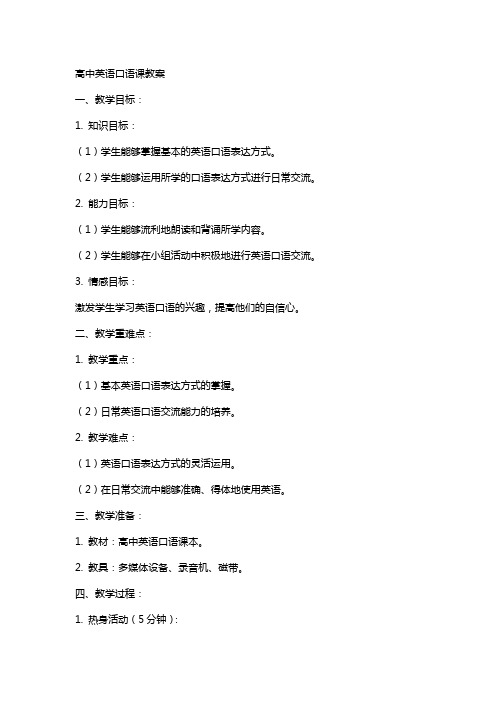
高中英语口语课教案一、教学目标:1. 知识目标:(1)学生能够掌握基本的英语口语表达方式。
(2)学生能够运用所学的口语表达方式进行日常交流。
2. 能力目标:(1)学生能够流利地朗读和背诵所学内容。
(2)学生能够在小组活动中积极地进行英语口语交流。
3. 情感目标:激发学生学习英语口语的兴趣,提高他们的自信心。
二、教学重难点:1. 教学重点:(1)基本英语口语表达方式的掌握。
(2)日常英语口语交流能力的培养。
2. 教学难点:(1)英语口语表达方式的灵活运用。
(2)在日常交流中能够准确、得体地使用英语。
三、教学准备:1. 教材:高中英语口语课本。
2. 教具:多媒体设备、录音机、磁带。
四、教学过程:1. 热身活动(5分钟):教师与学生进行简单的英语口语交流,提问学生关于日常生活的话题,引导学生积极参与。
2. 新课内容展示(15分钟):(1)教师引导学生学习新的口语表达方式,通过例句和情景演示,让学生理解并掌握这些表达方式。
(2)学生跟读并模仿,教师给予纠正和指导。
3. 小组活动(15分钟):学生分组,进行角色扮演,运用所学的口语表达方式进行交流。
教师巡回指导,纠正发音和表达错误。
4. 口语练习(10分钟):学生个体或小组为单位,进行口语练习,教师监听并给予评价。
五、作业设计:1. 抄写并背诵本节课所学的口语表达方式。
2. 结合所学内容,与同学进行英语口语交流,记录交流过程。
六、教学评价:1. 课堂表现评价:观察学生在课堂上的参与程度、口语表达的准确性和流畅性,以及小组活动中的合作态度。
2. 作业评价:检查学生作业的完成质量,包括口语表达的准确性和应用能力。
3. 口语测试:在课程结束后,组织一次口语测试,以评估学生对课程内容的掌握程度。
七、教学反思:在课程结束后,教师应进行教学反思,分析教学过程中的成功与不足,根据学生的反馈调整教学方法和内容,以便更有效地提高学生的英语口语能力。
八、课程拓展建议:1. 组织英语角活动,让学生在轻松的氛围中练习口语。
关于教师资格证高中英语教案模板
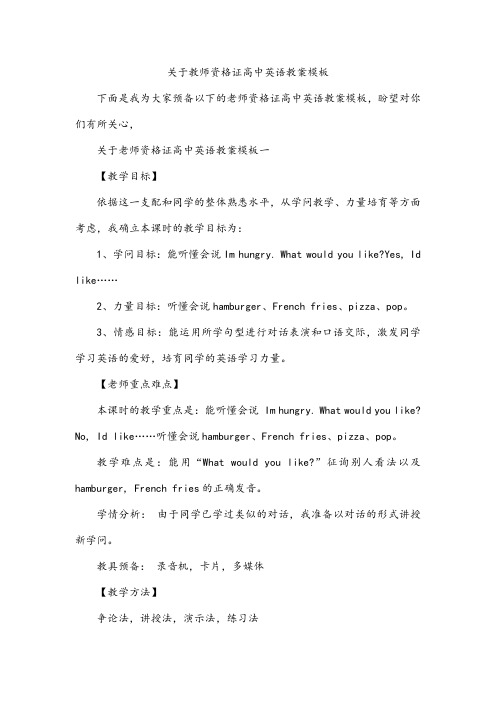
关于教师资格证高中英语教案模板下面是我为大家预备以下的老师资格证高中英语教案模板,盼望对你们有所关心,关于老师资格证高中英语教案模板一【教学目标】依据这一支配和同学的整体熟悉水平,从学问教学、力量培育等方面考虑,我确立本课时的教学目标为:1、学问目标:能听懂会说Im hungry. What would you like?Yes, Id like……2、力量目标:听懂会说hamburger、French fries、pizza、pop。
3、情感目标:能运用所学句型进行对话表演和口语交际,激发同学学习英语的爱好,培育同学的英语学习力量。
【老师重点难点】本课时的教学重点是:能听懂会说 Im hungry. What would you like? No, Id like……听懂会说hamburger、French fries、pizza、pop。
教学难点是:能用“What would you like?”征询别人看法以及hamburger, French fries的正确发音。
学情分析:由于同学已学过类似的对话,我准备以对话的形式讲授新学问。
教具预备:录音机,卡片,多媒体【教学方法】争论法,讲授法,演示法,练习法【教学程序】为实现以上目标,我是这样设计教学过程的:(一)、Warming up1、Sing some songs.2、Play a game.快速呈现食物图片,做问答。
(通过唱唱、问答的形式,不仅吸引同学的留意力,调动乐观性,而且营造了学习英语的氛围。
同时也为本课的教学作了学问的铺垫,构建了学问表象。
)(二)、Revision(紧接着老师摸着肚子,作饥饿状)引导同学一起说出Im hungry,围绕呈现的图片快速对话。
(以对话的形式,唤起同学的记忆,使同学娴熟运用旧知,同时对Im hungry进行了渗透。
)(三)、Presentation1、依次呈现some bread、some juice的图片。
关于教师资格证高中英语教案模板
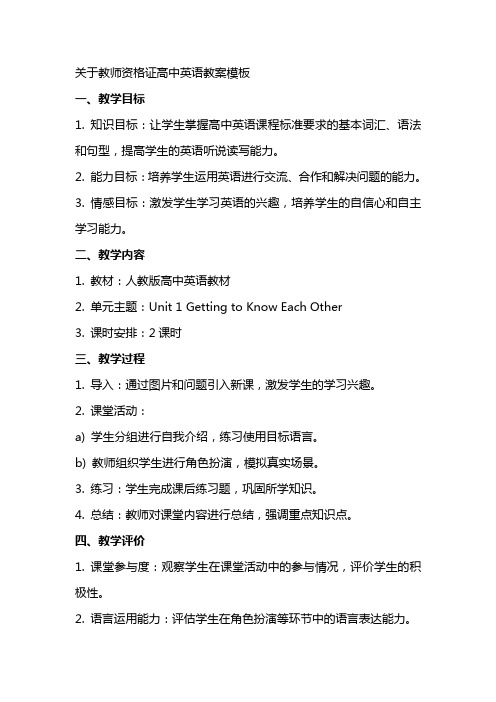
关于教师资格证高中英语教案模板一、教学目标1. 知识目标:让学生掌握高中英语课程标准要求的基本词汇、语法和句型,提高学生的英语听说读写能力。
2. 能力目标:培养学生运用英语进行交流、合作和解决问题的能力。
3. 情感目标:激发学生学习英语的兴趣,培养学生的自信心和自主学习能力。
二、教学内容1. 教材:人教版高中英语教材2. 单元主题:Unit 1 Getting to Know Each Other3. 课时安排:2课时三、教学过程1. 导入:通过图片和问题引入新课,激发学生的学习兴趣。
2. 课堂活动:a) 学生分组进行自我介绍,练习使用目标语言。
b) 教师组织学生进行角色扮演,模拟真实场景。
3. 练习:学生完成课后练习题,巩固所学知识。
4. 总结:教师对课堂内容进行总结,强调重点知识点。
四、教学评价1. 课堂参与度:观察学生在课堂活动中的参与情况,评价学生的积极性。
2. 语言运用能力:评估学生在角色扮演等环节中的语言表达能力。
3. 课后练习:检查学生完成的练习题,评估学生的掌握程度。
五、教学资源1. 教材:人教版高中英语教材2. 图片:与课堂内容相关的图片3. 多媒体课件:用于辅助教学六、教学策略1. 交际式教学法:通过小组活动、角色扮演等形式,让学生在实际语境中运用英语,提高口语交际能力。
2. 任务型教学法:教师设计各种任务,引导学生参与课堂实践,培养学生的综合语言运用能力。
3. 情境教学法:创设真实、生动的情境,让学生在情境中自然地学习和使用英语。
七、教学步骤1. Step 1: 导入新课,展示图片,引导学生谈论相关话题。
2. Step 2: 教师讲解新知识点,如词汇、语法和句型。
3. Step 3: 学生进行小组活动,练习使用新学的语言点。
4. Step 4: 角色扮演:学生分角色表演,运用所学知识。
5. Step 5: 教师组织学生进行听力、阅读和写作训练。
6. Step 6: 课堂总结,布置课后作业。
教师资格证考试英语教案模板
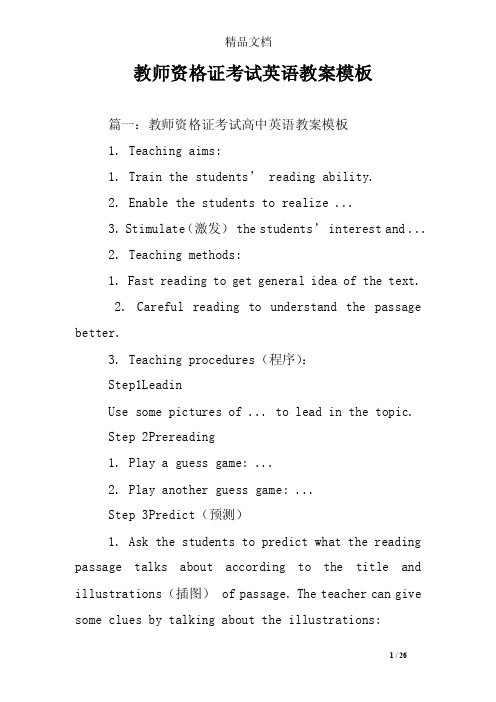
教师资格证考试英语教案模板篇一:教师资格证考试高中英语教案模板1. Teaching aims:1. Train the students’ reading ability.2. Enable the students to realize ...3. Stimulate(激发) the students’ interest and ...2. Teaching methods:1. Fast reading to get general idea of the text.2. Careful reading to understand the passage better.3. Teaching procedures(程序):Step1LeadinUse some pictures of ... to lead in the topic.Step 2Prereading1. Play a guess game: ...2. Play another guess game: ...Step 3Predict(预测)1. Ask the students to predict what the reading passage talks about according to the title and illustrations(插图) of passage. The teacher can give some clues by talking about the illustrations:...Step 4Skimming(略读)1. Let the students skim the whole passage to get the main idea, then evaluate their predictions. During this activity, the teacher should give some guidance (指导) on reading skills.Main idea of the passage:...2. Let the students skim the passage and divide it into different parts to find out the main idea of every part an the topic sentences.Part 1 (paragraph 1...)......Step 5Careful reading... (问题)Ask the students to scan the second part and complete the chart(图表)with information from the passage.Ask the students to read carefully and finish the following tasks:...(设计一些问题或判断对错等)Knowledge aims1. To listen to and understand the listening materials.2. Students can master the following expressions:...(一些句型)Ability aims1. Enable students to catch and understand the listening materials.2. Develop students’ ability to get special information and take note while listening.3. Get students to learn and use the expressions of ...Emotional aim1. Enable students to know more about ...2. Develop students’ sense of ...Teaching proceduresStep 1LeadinPlay a game ...1. Put students into pairs. Give them each two minutes to think of ......(游戏过程)Step 2Prelistening1. Tell students they will listen to a dialogue about ...2. Give students some directions and make them predict what the listening text is about.Step 3Whilelistening1. Tell students listen to the tape first to get the main idea and decide whether their prediction gist right or not.2. Ask students to listen to the tape again. Let them listen and answer some questions. (Show the questions on the blackboard)3. Students exchange the information and listen to the tape a third time for checking. Let them have the correct answers.Step 4Postlistening1. Give 23 minutes to students to ask questions if they have any.2. Show students the listening text and let them read it aloud.3. Let students read aloud the questions and expressions on the blackboard: ...(之前目标里的句型)4. Make sure they will understand and enable to use the, Then let them in Pairs discuss ...5. Get some pairs to act out their dialogue in front of the class.Step 5Homework1. Make sentences with the expressions in the lesson.2. Surf the internet to find out more information about ...3. 给一篇文章用来讲语法的课堂设计Knowledge objectivesTo learn the use of ... (语法点)Ability objectivesTo use ... (语法)correctly and properly according to the context.Emotional objectives1. To become interested in grammar learning.2. To develop the sense of group cooperationTeaching important pointsGet students to learn and master the new grammar item: ... (语法)Teaching difficult pointsEnable students to learn how to use ... correctly.Teaching proceduresStep 1Revision1. Check the homework exercises.2. Let students dictate some new words and expressions.Step 2Discovering useful structures1. Ask students to read through the passage ... , pick out the sentences where ...(语法) are, and then underline ... (语法)2. Let students work in pairs to translate these sentences and try to understand the use of ...3. Have students observe the sentences and draw the conclusion: ...Step 3Understanding and summarizing1. Ask students to work in pairs to finish the following exercises on how ... are used. (Show thefollowing on the screen)...Step 4Using structures(Show the following exercises on the screen or give out exercises papers.) Answer the following questions using ......1. Ask students to work in group of four.2. Give them four minutes to finish the work and ask each group to choose the best answers.3. Ask students to choose the best sentences.Step 5Playing the gameGet into groups and play the game:Step 6Closing down by a quiz.(Show some exercises on the screen.)Let students finish them within a few minutes, then check the answers with the whole class.Knowledge objectivesBy the end of this lesson the students:1. will have a better understanding of the structure and characteristics of an advertisement.2. will grasp some useful words and expressionsto describe a good restaurant such as: ...Ability objectives1. To grasp the use of persuasive sentences.2. To improve the ability of in gathering, analyzing, comparing and making conclusion.Moral objectives1. To improve the students’ learning motivation.2. To make the students become confident.3. To improve their ability of cooperating with each other through discussing. Teaching important and difficult pointsTaskbased approach, cooperating approach and communicative approach. Teaching procedures Step 1Revision lead inFirst check the homework of last class.Then let the students swap the homework with each other and discuss in groups of 4, take notes, find out and category the impressive sentences into 5 kinds of information: ...Step 2Discussing1. Show students 4 pictures of ...2. Ask 3 students to report their work, show themthe pictures of ...Step 3Prewriting1. Show them the sample ...2. Read the ... and think over what are the characteristics of ... , encourage some students to analyze and tell their opinion.Step 4Whilewriting1. Ask students to read the requirements on the text.2. Ask them to write the topic sentence first, and then write at least 6 supporting sentences to ...Step 5PostwritingLet them swap their passage with each other and recommend 3 most successful ... Step 6Homework1. Polish students’ writing and write some more aspects of ...Their final work will be modified and selected, then the most successful ones will be put up on the English Corner.2. Review the words and expressions in this unit.Teaching aims1. To know the meaning and usage of the following words: ...To understand some important sentences in the text and know the structure and usage of inversion.2. To master the microreading skills through skimming and scanning.3. To know the ability and knowledge ... and develop the ability of getting information from the passage and dealing with the information.Teaching methodsTaskbased learning; situational learning; group work learning.The key and difficult points1. To enable the students to get the main idea of the passage, analyze the structure, and get useful information.2. To train the students of microreading skills such as skimming and scanning, and develop their ability of reorganizing and transferring information.Teaching processStep 1PrereadingQuestion:Step 2SkimmingQuestions( To explain some words and structures.)Step 3Detailed readingStep 4InterviewStep 5SummaryStep 6Homework1. Read and practice the dialogue after class fluently.2. Find the useful words and expressions in the passage and do exercises on the textbook following the passage to consolidate them.篇二:教师资格证考试英语教案写作Class type: reading/listening/speaking/writing classTeaching contentsComprehension of the given text.Difficult words and phrases about 主题It is contains /about……(概括文章主题或大意)Teaching objectives1.Knowledge objectivesMaster the words of /related to 主题 and grasp the usage of….. Master the following words and phrases, grammar:Understand the main idea and some details of the passage/dialogue Have a better understanding of /learn more about 主题或人物Talk about 与主题相关的人或事物and write dialogues/communicate with new words and grammar.2.Ability objectivesImprove their reading ability, especially skimming and scanning ability. Improve their ability of listening, speaking and writing, comprehension. Develop ability in ……Set up effective studying strategies.3.Emotional objectivesGet more interested in\have more interest in ……(通用 English culture/studying)Develop their spirit of cooperating with others/exploring.Cultivate scientific attitude/habits in their lives.Combine English learning with daily life and arouse students’ interest in learning English.Speak confidently in front of the class.Teaching key pointsNew words of 主题;description of 主题; usage of ……To train students grasp the main idea and details of the passage. Teaching difficult pointsUse … in the proper situations correctly.To improve students’… ability, especially the ability of catching key words.Teaching aidsMultimedia ,pictures of… flash cardsTeaching proceduresStep1 warming up/leadin (35min)方案1 直观导入法1. Greeting.2. Show students pictures of…/play a video about …/play the music of and ask students to answer what they saw/listened/got(justification: it will arouse students’interest in learning this lesson and lead to the main idea of the text. )方案2 问题导入法1. Greeting2. Brainstorm: questions and answersAsk students the following questions:(justification: it will help students to combine English learning with daily life and lead to the topic of passage.)Step2 presentation (1820min)/prereading (57min)1. Introduction of pronunciations and meanings of the main words and phrases.(转自: 蓬勃范文 :教师资格证考试英语教案模板)2. Sharing what is already known about topic.Step3 consolidation (810min)/whilereading (1820min)1. General reading/fast readingask students to read the passage quickly and then conclude the main idea of each paragraph/the whole passage.(justification: train students’ reading ability of scanning for the general of passage.)2. careful readingA ask students to read the passage carefully and do the True or False exercises/ ask students to answer the following questions.B ask students to fill in the table/blanksaccording to the text. C ask students to read the passage loudly and carefully again.(justification: it will improve students’reading skills for looking specific information and help students have a better understanding of the passage.)Step4 summary and homework(5min)/postreading (810min)Ask students to work in groups and have a competition to retell the passage according to the outline and key words on PPT.Outline of the text:………Key words:………(justification: it help students to strengthen /consolidate what they have learned .)/Step5 summary and homeworkSummary:1. show the flash cards of words, phrases and sentences to lead students to read and review them again.2. Make a clear summary on what they have learned.Homework:1. Ask students to review the important words andphrases .2. Ask students to share what they have learned with their parents.3. Ask students to search for more information about……and write a short passage about 主题. (justification: it can not only help students review and consolidate what they have learned ,but also broaden their eyesight.)Blackboard Design篇三:教师资格证考试高中英语教案模板1. Teaching aims:1. Train the students’ reading ability.2. Enable the students to realize ...3. Stimulate(激发) the students’ interest and ...2. Teaching methods:1. Fast reading to get general idea of the text.2. Careful reading to understand the passage better.3. Teaching procedures(程序):Step1LeadinUse some pictures of ... to lead in the topic.Step 2Prereading1. Play a guess game: ...2. Play another guess game: ...Step 3Predict(预测)1. Ask the students to predict what the reading passage talks about according to the title and illustrations(插图) of passage. The teacher can give some clues by talking about the illustrations: ......Step 4Skimming(略读)1. Let the students skim the whole passage to get the main idea, then evaluate their predictions. During this activity, the teacher should give some guidance (指导) on reading skills.Main idea of the passage:...2. Let the students skim the passage and divide it into different parts to find out the main idea of every part an the topic sentences.Part 1 (paragraph 1...)......Step 5Careful reading... (问题)Ask the students to scan the second part and complete the chart(图表)with information from the passage.Ask the students to read carefully and finish the following tasks:......Read the statements and decide whether it is true or false and give the reason. (设计一些问题或判断对错等)Knowledge aims1. To listen to and understand the listening materials.2. Students can master the following expressions:...(一些句型)Ability aims1. Enable students to catch and understand the listening materials.2. Develop students’ ability to get special information and take note while listening.3. Get students to learn and use the expressions of ...Emotional aim1. Enable students to know more about ...2. Develop students’ sense of ...Teaching proceduresStep 1LeadinPlay a game ...1. Put students into pairs. Give them each two minutes to think of ......(游戏过程)Step 2Prelistening1. Tell students they will listen to a dialogue about ...2. Give students some directions and make them predict what the listening text is about.Step 3Whilelistening1. Tell students listen to the tape first to get the main idea and decide whether their prediction gist right or not.2. Ask students to listen to the tape again. Letthem listen and answer some questions. (Show the questions on the blackboard)3. Students exchange the information and listen to the tape a third time for checking. Let them have the correct answers.Step 4Postlistening1. Give 23 minutes to students to ask questions if they have any.2. Show students the listening text and let them read it aloud.3. Let students read aloud the questions and expressions on the blackboard: ...(之前目标里的句型)4. Make sure they will understand and enable to use the, Then let them in Pairs discuss ...5. Get some pairs to act out their dialogue in front of the class.Step 5Homework1. Make sentences with the expressions in the lesson.2. Surf the internet to find out more information about ...3. 给一篇文章用来讲语法的课堂设计Knowledge objectivesTo learn the use of ... (语法点)Ability objectivesTo use ... (语法)correctly and properly according to the context.Emotional objectives1. To become interested in grammar learning.2. To develop the sense of group cooperationTeaching important pointsGet students to learn and master the new grammar item: ... (语法)Teaching difficult pointsEnable students to learn how to use ... correctly.Teaching proceduresStep 1Revision1. Check the homework exercises.2. Let students dictate some new words and expressions.Step 2Discovering useful structures1. Ask students to read through the passage ... , pick out the sentences where ...(语法) are, and thenunderline ... (语法)2. Let students work in pairs to translate these sentences and try to understand the use of ...3. Have students observe the sentences and draw the conclusion: ...Step 3Understanding and summarizing1. Ask students to work in pairs to finish the following exercises on how ... are used. (Show the following on the screen)...Step 4Using structures(Show the following exercises on the screen or give out exercises papers.) Answer the following questions using ......1. Ask students to work in group of four.2. Give them four minutes to finish the work and ask each group to choose the best answers.3. Ask students to choose the best sentences.Step 5Playing the gameGet into groups and play the game:Step 6Closing down by a quiz.(Show some exercises on the screen.)Let students finish them within a few minutes, then check the answers with the whole class.Knowledge objectivesBy the end of this lesson the students:1. will have a better understanding of the structure and characteristics of an advertisement.2. will grasp some useful words and expressions to describe a good restaurant such as: ...Ability objectives1. To grasp the use of persuasive sentences.2. To improve the ability of in gathering, analyzing, comparing and making conclusion.Moral objectives1. To improve the students’ learning motivation.2. To make the students become confident.3. To improve their ability of cooperating with each other through discussing. Teaching important and difficult pointsTaskbased approach, cooperating approach and communicative approach. Teaching procedures Step 1Revision lead inFirst check the homework of last class.Then let the students swap the homework with each other and discuss in groups of 4, take notes, find out and category the impressive sentences into 5 kinds of information: ...Step 2Discussing1. Show students 4 pictures of ...2. Ask 3 students to report their work, show them the pictures of ...Step 3Prewriting1. Show them the sample ...2. Read the ... and think over what are the characteristics of ... , encourage some students to analyze and tell their opinion.Step 4Whilewriting1. Ask students to read the requirements on the text.2. Ask them to write the topic sentence first, and then write at least 6 supporting sentences to ...Step 5PostwritingLet them swap their passage with each other and recommend 3 most successful ... Step 6Homework1. Polish students’ writing and write some more aspects of ...Their final work will be modified and selected, then the most successful ones will be put up on the English Corner.2. Review the words and expressions in this unit.Teaching aims1. To know the meaning and usage of the following words: ...To understand some important sentences in the text and know the structure and usage of inversion.2. To master the microreading skills through skimming and scanning.3. To know the ability and knowledge ... and develop the ability of getting information from the passage and dealing with the information.Teaching methodsTaskbased learning; situational learning; group work learning.The key and difficult points1. To enable the students to get the main idea of the passage, analyze the structure, and get useful information.2. To train the students of microreading skills such as skimming and scanning, and develop their ability of reorganizing and transferring information.Teaching processStep 1PrereadingQuestion:Step 2SkimmingQuestions( To explain some words and structures.)Step 3Detailed readingStep 4InterviewStep 5SummaryStep 6Homework1. Read and practice the dialogue after class fluently.2. Find the useful words and expressions in the passage and do exercises on the textbook following the passage to consolidate them.。
高中英语教师资格证教案模板

高中英语教师资格证教案模板第1篇:教师资格证考试高中英语教案1.阅读课的教学方案1.Teaching aims: 1.Train the students’ reading ability.2.Enable the students to realize...3.Stimulate(激发)the students’ interest and...2.Teaching methods: 1.Fast reading to get general idea of the text.2.Careful reading to understand the paage better.3.Teaching procedures(程序): Step1Lead-in Use some pictures of...to lead in the topic.Step 2Pre-reading 1.Play a gue game:...2.Play another gue game:...Step 3Predict(预测)1.Ask the students to predict what the reading paage talks about according to the title and illustrations(插图)of paage.The teacher can give some clues by talking about the illustrations:......Step 4Skimming(略读)1.Let the students skim the whole paage to get the main idea, then evaluate their predictions.During this activity, the teacher should give some guidance(指导)on reading skills.Main idea of the paage:...2.Let the students skim the paage and divide it into different parts to find out the main idea of every part an the topic sentences.Part 1(paragraph 1...)......Step 5Careful reading...(问题)Ask the students to scan the second part and complete the chart(图表)with information from the paage.Ask the students to read carefully and finish the following tasks:......(设计一些问题或判断对错等)2.听说课的教学方案:Knowledge aims 1.To listen to and understand the listening materials.2.Students can master the following expreions:...(一些句型)Ability aims 1.Enable students to catch and understand the list ening materials.2.Develop students’ ability to get special information and take note while listening.3.Get students to learn and use the expreions of...Emotional aim 1.Enable students to know more about...2.Develop students’ sense of...Teaching procedures Step 1Lead-in Play a game...1.Put students into pairs.Give them each two minutes to think of......(游戏过程)Step 2Pre-listening 1.Tell students they will listen to a dialogue about...2.Give students some directions and make them predict what the listening text is about.Step 3While-listening 1.Tell students listen to the tape first to get the main idea and decide whether their prediction gist right or not.2.Ask students to listen to the tape again.Let them listen and answer some questions.(Show the questions on the blackboard)3.Students exchange the information and listen to the tape a third time for checking.Let them have the correct answers.Step 4Post-listening 1.Give 2-3 minutes to students to ask questions if they have any.2.Show students the listening text and let them read it aloud.3.Let students read aloud the questions and expreions on the blackboard:...(之前目标里的句型)4.Make sure they will understand and enable to use the, Then let them in Pairs discu...5.Get some pairs to act out their dialogue in front of the cla.Step 5Homework 1.Make sentences with the expreions in the leon.2.Surf the internet to find out more information about...3.给一篇文章用来讲语法的课堂设计Knowledge objectives To learn the use of...(语法点)Ability objectivesTo use...(语法)correctly and properly according to the context.Emotional objectives1.To become interested in grammar learning.2.To develop the sense of group cooperation Teaching important points Get students to learn and master the new grammar item:...(语法)Teaching difficult points Enable students to learn how to use...correctly.Teaching procedures Step 1Revision 1.Check the homework exercises.2.Let students dictate some new words and expreions.Step 2Discovering useful structures 1.Ask students to read through the paage..., pick out the sentences where...(语法)are, and then underline...(语法)2.Let students work in pairs to translate these sentences and try to understand the use of...3.Have students observe the sentences and draw the conclusion:...Step 3Understanding and summarizing1.Ask students to work in pairs to finish the following exercises on how...are used.(Show the following on the screen)...Step 4Using structures(Show the following exercises on the screen or give out exercises papers.)Answer the following questions using......1.Ask students to work in group of four.2.Give them four minutes to finish the work and ask each group to choose the best answers.3.Ask students to choose the best sentences.Step 5 Playing the game Get into groups and play the game: Step 6 Closing down by a quiz.(Show some exercises on the screen.)Let students finish them within a few minutes, then checkthe answers with the whole cla.4.写作课的教学方案Knowledge objectives By the end of this leon the students: 1.will have a better understanding of the structure and characteristics of an advertisement.2.will grasp some useful words and expreions to describe a good restaurant such as:...Ability objectives 1.To grasp the use of persuasive sentences.2.T o improve the ability of in gathering, analyzing, comparing and making conclusion.Moral objectives 1.To improve the students’ learning motivation.2.To make the students become confident.3.To improve their ability of cooperating with each other through discuing.Teaching important and difficult points Task-based approach, cooperating approach and communicative approach.Teaching procedures Step 1 Revision & lead in First check the homework of last cla.Then let the students swap the homework with each other and discu in groups of 4, take notes, find out and category the impreive sentences into 5 kinds of information:...Step 2Discuing 1.Show students 4 pictures of...2.Ask 3 students to report their work, show them the pictures of...Step 3Pre-writing 1.Show them the sample...2.Read the...and think over what are the characteristics of..., encourage some students to analyze and tell their opinion.Step 4While-writing 1.Ask students to read the requirements on the text.2.Ask them to write the topic sentence first, and then write at least 6 supporting sentences to...Step 5Post-writing Let them swap their paage with each other and recommend 3 most succeful...Step 6Homework1.Polish students’ writing and write some more aspects of...Their final work will be modified and selected, then the mostsucceful ones will be put up on the English Corner.2.Review the words and expreions in this unit.5.阅读课的教学方案Teaching aims 1.T o know the meaning and usage of the following words:...To understand some important sentences in the text and know the structure and usage of inversion.2.T o master the micro-reading skills through skimming and scanning.3.T o know the ability and knowledge...and develop the ability of getting information from the paage and dealing with the information.Teaching methods Task-based learning;situational learning;group work learning.The key and difficult points 1.To enable the students to get the main idea of the paage, analyze the structure, and get useful information.2.T o train the students of micro-reading skills such as skimming and scanning, and develop their ability of reorganizing and transferring information.Teaching proce Step 1Pre-reading Question: Step 2Skimming Questions(To explain some words and structures.)Step 3Detailed reading Step 4Interview Step 5Summary Step 6Homework 1.Read and practice the dialogue after cla fluently.2.Find the useful words and expreions in the paage and do exercises on the textbook following the paage to consolidate them.第2篇:高中英语教师资格证课教案Teaching Plan Teaching Aims:1.Knowledge aim: students will be able to understand the main idea and some details of the paage.2.Ability aim: students will be able to use reading skills such as skimming andscanning.3.Emotional aim: Students can get more interested in English culture.Teaching Procedures: 1.Step one: warming-up lead-in(1 minutes)Greeting.Show the students some pictures or play a song about … and ask them some simple questions: …2.Step two: pre-reading(2 minutes)Common sense on…Ask students to give examples of…Play the video about ….While enjoy the video, students think over the following ques tions: ….3.Step three: while-reading(4 minutes)Read the text for the students and then ask them to conclude the main idea of the paage.Main idea: …Ask the students to read the paage carefully and decide whether the statements are true or false and explai n why: …Ask the students to work in groups and have a discuion on the following questions: …4.Step Four: post-reading(2 minutes)Ask students to retell the paage.Ask students to retell between partners first, then ask two students to retell before cla.5.Step Five: Summary and Homework(1 minutes)Briefly review the content learned today.Let the students to write a composition about the ending of this story.T: Good morning, boys and girls.How are you today? Great!Today, we are going to learn a new leon, but before the cla, I want to show you some pictures.Well, what do you see in the pictures? Great!How do you feel about…? Do you have any experience about…?T: Well, …(common sense).Can you name some examples of …? Ok, Peter, please.T: …, yes, great!How about y ou, Lily?T: … and ….Well done.[Now, I will play a video for you.Please think over ‘…’ while you enjoy the video.] T: Ok, the video is over, who want to share his opinion with us? Aslan, go ahead.T:Thanks for sharing.As we have talked a lot about the …, n ow open your book andturn to page 51.Let’s move on the learn the text about (I)will read the text for you.While reading, please try to conclude the main idea of the paage.Here we go!(读课文)T: Ok, do you understand the whole paage? Great!So, who volunteer to answer the question: what’s the main idea of the paage? Lily, please.T: Good job!This paage is mainly about … It’s very interesting.Now, please read it carefully and then do the true or false on the PPT.T: Have you finished? Good.So is the first stateme nt true or false? Helen, what’s your answer? T: Yes, it’s true.What about the second one? …(句子)true or false? OK, Stacey please.T: Yes!It’s false.But can you explain why?T: Excellent!It’s false because … Now, the last one.Any volunteer? Great, Mike, pleas e.T: Yes, it’s true, too.Now, can you understand the whole text? Great.If we must understand this reading material thoroughly, we should pay more attention to each and very fact in this reading material in order to understanding the text.[ In the following part, we will do some further study.Please work in groups and have a discuion on the questions shown on the ppt: … ten minutes.T: Ok, time is up.Which group wants to share your opinion? Great, please!T: Well done.I can feel that you have thought it thoroughly.Is there any group has different opinions? Well, this group.T: you did a good job too.…(问题答案)] T: Well, we have read the text thoroughly and it seems like all of you have understood it.Now please work in pairs and try to retell the paage.I’ll give you ten minutes and then I’ll ask two students to do the presentation.Let’s start.T: Time is up.Who want to retell the paage first? Come on, don’t be shy!Great, Lily.T:Excellent!Anyone else? Mark, please.T: Very good!T: Ok, so much for today.As we have lear ned … it’s very interesting.Please write a composition about the ending of the story after cla.That’s all, you can have a break now.第3篇:教师资格证高中英语试讲教案单位:班别:姓名:JuniorUnit14 The birth of a festivalⅠ.Teaching aims 1.Talk about festival and customs2.Practice expreing and supporting an opinion3.Introduceda festival of ChinaⅡ.Knowledge aims Words: harvest, honors, ancestor, creatively, generation, purpose, faith, commercial, similar, salute, celebration…..Phrases:hear about, so that, as well as, believe in, get together, playa trick on sb… Sentence:1.Kwanzaa was born in 1966, when people created a new festival so that African American would be able to celebrate their history and culture.2.The African first-fruit festivals had many things in common.3.We must do as much as we can to make our community better and more beautiful.4.Since Kwanzaa is a time for learning as well as joy, people celebrate itby lighting a candle each day and discuing one of the seven principles of Kwanzaa.Grammar hear about=learnt about hear of sb.=have a knowledge of sb.have much/great faith in sb./sth.have little/no faith in sb./sth.keep faith with sb.as well as+clausedo as much as sb.can do have honour to sb.=do honour to sb.(do sb.honour)Ⅲ.Teaching key and difficult points:Teaching key: understand the text and using your own words to retell the text.Difficult point:how to use phrases: as well as, so that, have … in common.IV.Teaching aids:1)Raising question approach 2)Discuion approach3)task-based approach*Teaching means: use the multi-media as an aistant means in teaching.3Ⅳ.Teaching steps: Step 1 Lead-in1)Have a free talk about festival in China, and then discu the question in Pre-reading on page 10.1.How does your family celebrate the Spring Festival? 2.Why do we celebrate the Spring Festival? 3.Do festivals help us understand our history and culture?4.What kind of gifts and things do people buy during major festival like Christmas and the Spring Festival? 2)Show the student 3 p ictures about Kwanzaa and then discu what’s the picture about ?Step 2 Listening comprehensions1)Present the students the questions before listening to the text.2)Get the students to listen to the tape and then answer the following questions.① Why did people create Kwanzaa? ② Many festival around the world are celebrated around the same time.Why do we celebrate these festivals at these times?Step 3 Fast reading1)Tell the students the task of reading before they read the text.42)After reading then summary the main idea of this text.Step 4 Language pointsPhrases: hear about, seven-day, celebrating, get together, so that, have…in common, harvest, honour, as well as, as much aswe can do, believe in, so that, keep faith with, show honour to sb., in honour of.Sentence: 1.Kwanzaa was born in 1966, when people created a new festival so that African American would be able to celebrate their history and culture.2.The African first-fruit festivals had many things in common.3.We must do as much as we can to make our community better and more beautiful.4.Since Kwanzaa is a time for learning as well as joy, people celebrate it by lighting a candle each day and discuing one of the seven principles of Kwanzaa..Step 5 Intensive reading1)Tell the students the task of reading before they read the paage once again.2)Get the students to read the paage more carefully and then discu the following questions in groups.5① Compare Kwanzaa with the Chinese Spring festival and Christmas.In which way are they similar and in which war are they different? ② Look at the seven principle of Kwanzaa.Which one do you think is the most important? Why? Are there any other festivals which have one or more of the same principles?Step 6 Task—based activity 1)Ask the students act as an announcer and introduce Mid-autumn festival to the cla.2)Show some picture for the students to watch.3)Give them some key words.August, traditional, Mid-autumn festival, moon cakes, Chang E, celebrate, get together, big dinner.4)Give the students an example when neceary.Step7 Summary1)Go through the important points and difficult points of this leon with the students once again.2)Come to the screen ① To know about the brief history of the Kwanzaa.② To get more information about the Kwanzaa.③ To master the important words, phrases and sentences.6④ To retell the text.Step 8 Homework 1)Finish some exercises.2)Write a paage about a festival of China.3)PreviewLeon15.7第4篇:教师资格证高中英语试讲教案JuniorUnit14 The birth of a festivalⅠ.Teaching aims1.Talk about festival and customs2.Practice expreing and supporting an opinion3.Introduceda festival of ChinaⅡ.Knowledge aims Words: harvest, honors, ancestor, creatively, generation, purpose, faith, commercial, similar, salute, celebration…..Phrases:hear about, so that, as well as, believe in, get together, playa trick on sb… Sentence:1.Kwanzaa was born in 1966, when people created a new festival so that African American would be able to celebrate their history and culture.2.The African first-fruit festivals had many things in common.3.We must do as much as we can to make our community better and more beautiful.4.Since Kwanzaa is a time for learning as well as joy, people celebrate it by lighting a candle each day and discuing one of the seven principles of Kwanzaa.1 Grammar hear about=learnt abouthear of sb.=have a knowledge of sb.have much/great faith in sb./sth.have little/no faith in sb./sth.keep faith with sb.as well as+clausedo as much as sb.can do have honour to sb.=do honour to sb.(do sb.honour)Ⅲ.Teaching key and di fficult points:Teaching key: understand the text and using your own words to retell the text.Difficult point:how to use phrases: as well as, so that, have … in common.IV.Teaching aids:1)Raising question approach 2)Discuion approach3)task-based approach*Teaching means: use the multi-media as an aistant means in teaching.Ⅳ.T eaching steps: Step 1 Lead-in1)Have a free talk about festival in China, and then discu the question in Pre-reading on page 10.1.How does your family celebrate the Spring Festival? 2.Why do we celebrate the Spring Festival? 3.Do festivals help us understand our history and culture?4.What kind of gifts and things do people buy during major festival like Christmas and the Spring Festival? 2)Show the student 3 pictures about Kwanzaa and then discu what’s the picture about ?Step 2 Listening comprehensions1)Present the students the questions before listening to the text.2)Get the students to listen to the tape and then answer the following questions.① Why did people create Kwanzaa? ② Many festival around the world are celebrated around the same time.Why do we celebrate these festivals at these times?Step 3 Fast reading1)Tell the students the task of reading before they read the text.2)After reading then summary the main idea of this text.3 Step 4 Language pointsPhrases: hear about, seven-day, celebrating, get together, so that, have…in common, harvest, honour, as well as, as much as we can do, believe in, so that, keep faith with, show honour to sb., in honour of.Sentence: 1.Kwanzaa was born in 1966, when people created a new festival so that African American would be able to celebrate their history and culture.2.The African first-fruit festivals had many things in common.3.We must do as much as we can to make our community better and more beautiful.4.SinceKwanzaa is a time for learning as well as joy, people celebrate it by lighting a candle each day and discuing one of the seven principles of Kwanzaa..Step 5 Intensive reading1)Tell the students the task of reading before they read the paage once again.2)Get the students to read the paage more carefully and then discu the following questions in groups.① Compare Kwanzaa with the Chinese Spring festival and Christmas.In which way are they similar and in which war are they different?② Look at the seven principle of Kwanzaa.Which one do you think is the most important? Why? Are there any other festivals which have one or more of the same principles?Step 6 Task—based activity 1)Ask the students act as an announcer and introduce Mid-autumn festival to the cla.2)Show some picture for the students to watch.3)Give them some key words.August, traditional, Mid-autumn festival, moon cakes, Chang E, celebrate, get together, big dinner.4)Give the students an example when neceary.Step7 Summary1)Go through the important points and difficult points of this leon with the students once again.2)Come to the screen ① To know about the brief history of the Kwanzaa.② To get more information about the Kwanzaa.③ To master the important words, phrases and sentence s.④ T o retell the text.5第5篇:高中英语教师资格证词汇课教案教学内容:词义meanings、用法usage、词汇信息basic information、词汇记忆策略strategies.TopicTeaching Aims:1.Knowledge aim: The students will be able to know the meaning and usage of the following words:…2.Ability aim: The students will be able to use these wordscorrectly in writing and speaking.3.Emotional aim: The students will be more confident … Teaching Key and Difficult Points: Master the words, especially… Teaching Aid: CAI Teaching Procedures: 1.Step 1: lead-inShow some pictures to students and ask some questions:...2.Step 2: task-readingAsk students to read the text after the teacher and select the important words they think.Read the words twice.3.Step 3: presentation and comprehensionGo through those words.Introduce their meanings and usages.4.Step 4: practiceAsk students to do the exercise on Page 51: Fill in the blanks.Let students make up a story using all the words we learn today.5.Step 5: consolidationRead the words again.6.Step 7: HomeworkWrite those words down four times and recite them.Blackboard Design: Unit 6 Leon 1 Words:Good adj.book n.look vt.T: hello, boys and girls, how are you today? I’m fine too, thank you!Before the cla, let’s enjoy some pictures.What do you see in the first picture? T: a man.Right!What is he doing? Yes, he is ….T: In our daily life, … is very common, today, we will learn how to describe… in English.Please open the book and turn to page 51.Read the text after me and select the words you think important.T: Everyone well done.Who could s hare words with us? Peter, please.T: …(假装帮助读了一个单词,并且边读边板书)Great.…(重复一遍单词).Anything to add? Ok, Lily please.T: …(板书).Well down.T: Now, read after me.(没个词读两遍)T: 解释词语。
教师资格证考试高中英语教案模板
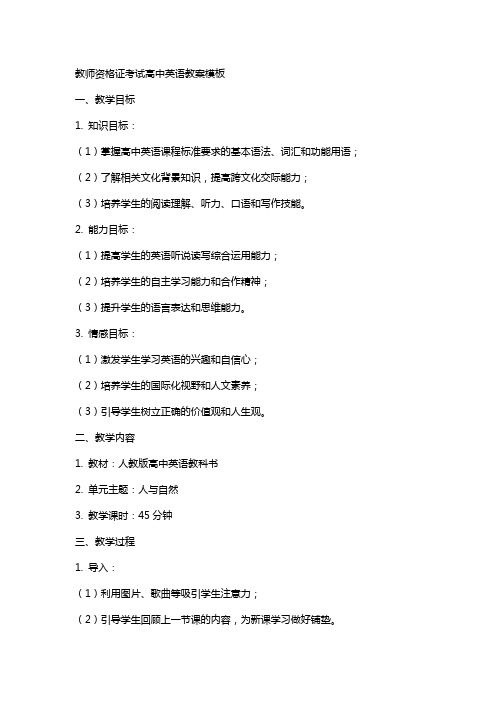
教师资格证考试高中英语教案模板一、教学目标1. 知识目标:(1)掌握高中英语课程标准要求的基本语法、词汇和功能用语;(2)了解相关文化背景知识,提高跨文化交际能力;(3)培养学生的阅读理解、听力、口语和写作技能。
2. 能力目标:(1)提高学生的英语听说读写综合运用能力;(2)培养学生的自主学习能力和合作精神;(3)提升学生的语言表达和思维能力。
3. 情感目标:(1)激发学生学习英语的兴趣和自信心;(2)培养学生的国际化视野和人文素养;(3)引导学生树立正确的价值观和人生观。
二、教学内容1. 教材:人教版高中英语教科书2. 单元主题:人与自然3. 教学课时:45分钟三、教学过程1. 导入:(1)利用图片、歌曲等吸引学生注意力;(2)引导学生回顾上一节课的内容,为新课学习做好铺垫。
2. 课堂讲解:(1)讲解本节课的重点语法和词汇;(2)通过例句和练习,帮助学生理解语法和词汇的用法;(3)介绍相关文化背景知识,提高学生的跨文化交际能力。
3. 课堂实践:(1)分组讨论:学生围绕主题进行小组讨论,锻炼口语表达能力;(2)小组竞赛:开展英语听力、口语、写作竞赛,激发学生的学习兴趣;(3)课堂互动:教师提问,学生回答,巩固所学知识。
4. 课后作业:(1)布置适量的作业,巩固课堂所学知识;(2)鼓励学生进行自主学习,提高学习效果。
四、教学评价1. 课堂表现:观察学生在课堂上的参与程度、发言情况等;2. 作业完成情况:检查学生作业的完成质量和速度;3. 考试成绩:定期进行单元测试,评估学生的学习效果。
五、教学资源1. 教科书;2. 教学课件;3. 图片、歌曲等辅助教学材料;4. 网络资源:如英语学习网站、在线词典等。
六、教学策略1. 情境教学:通过设定真实的生活情境,让学生在实际语境中学习英语;2. 任务型教学:布置具有挑战性的任务,让学生在完成任务的过程中运用英语;3. 交际式教学:鼓励学生积极参与课堂互动,提高口语表达能力和交际能力;4. 自主学习:引导学生制定学习计划,培养独立思考和解决问题的能力;5. 差异化教学:关注学生的个体差异,给予不同程度的学生个性化的指导。
教师资格证考试高中英语教案模板
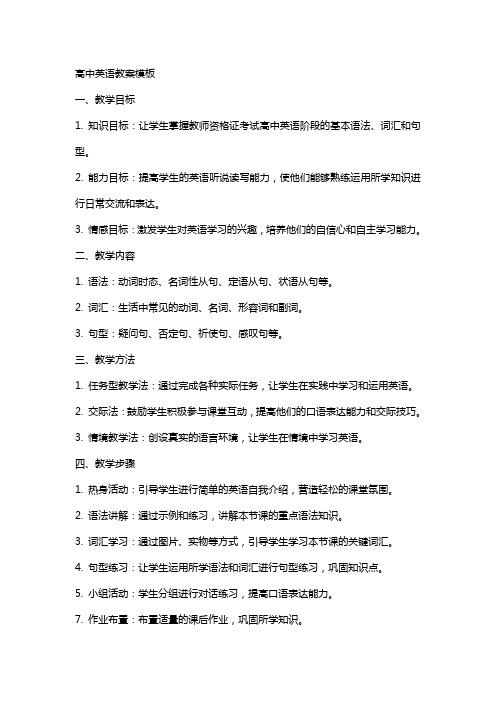
高中英语教案模板一、教学目标1. 知识目标:让学生掌握教师资格证考试高中英语阶段的基本语法、词汇和句型。
2. 能力目标:提高学生的英语听说读写能力,使他们能够熟练运用所学知识进行日常交流和表达。
3. 情感目标:激发学生对英语学习的兴趣,培养他们的自信心和自主学习能力。
二、教学内容1. 语法:动词时态、名词性从句、定语从句、状语从句等。
2. 词汇:生活中常见的动词、名词、形容词和副词。
3. 句型:疑问句、否定句、祈使句、感叹句等。
三、教学方法1. 任务型教学法:通过完成各种实际任务,让学生在实践中学习和运用英语。
2. 交际法:鼓励学生积极参与课堂互动,提高他们的口语表达能力和交际技巧。
3. 情境教学法:创设真实的语言环境,让学生在情境中学习英语。
四、教学步骤1. 热身活动:引导学生进行简单的英语自我介绍,营造轻松的课堂氛围。
2. 语法讲解:通过示例和练习,讲解本节课的重点语法知识。
3. 词汇学习:通过图片、实物等方式,引导学生学习本节课的关键词汇。
4. 句型练习:让学生运用所学语法和词汇进行句型练习,巩固知识点。
5. 小组活动:学生分组进行对话练习,提高口语表达能力。
7. 作业布置:布置适量的课后作业,巩固所学知识。
1. 课堂表现:观察学生在课堂上的参与程度、发音准确性、语法正确性等。
2. 作业完成情况:检查学生作业的完成质量,对错误进行纠正和指导。
3. 测试成绩:定期进行测试,评估学生的学习进度和成果。
六、教学资源1. 教材:使用教师资格证考试高中英语教材,如《高中英语》等。
2. 辅助材料:英语报纸、杂志、网络资源等,用于扩展学生的阅读和词汇量。
3. 多媒体设备:投影仪、计算机、音响等,用于展示教学内容和进行听力练习。
4. 教学挂图:用于展示语法结构和词汇图片。
5. 练习册:用于学生课后练习和巩固所学知识。
七、教学重点与难点1. 教学重点:掌握教师资格证考试高中英语阶段的基本语法、词汇和句型。
2. 教学难点:正确运用语法和词汇进行实际交流和表达。
教师资格证考试面试高中英语教案模板+逐字稿词汇课
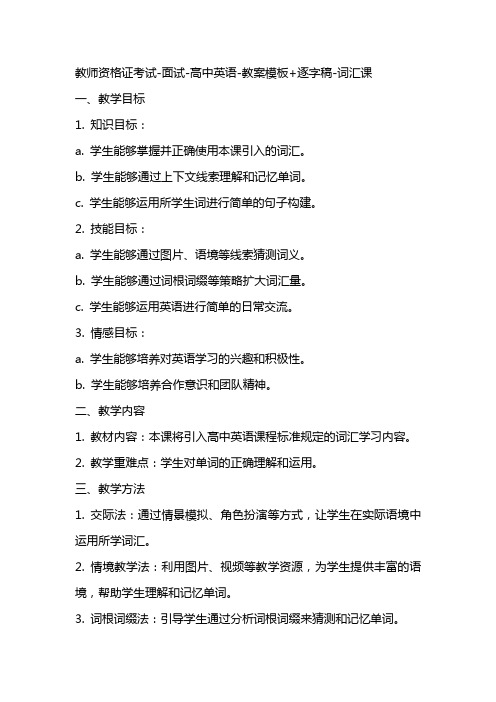
教师资格证考试-面试-高中英语-教案模板+逐字稿-词汇课一、教学目标1. 知识目标:a. 学生能够掌握并正确使用本课引入的词汇。
b. 学生能够通过上下文线索理解和记忆单词。
c. 学生能够运用所学生词进行简单的句子构建。
2. 技能目标:a. 学生能够通过图片、语境等线索猜测词义。
b. 学生能够通过词根词缀等策略扩大词汇量。
c. 学生能够运用英语进行简单的日常交流。
3. 情感目标:a. 学生能够培养对英语学习的兴趣和积极性。
b. 学生能够培养合作意识和团队精神。
二、教学内容1. 教材内容:本课将引入高中英语课程标准规定的词汇学习内容。
2. 教学重难点:学生对单词的正确理解和运用。
三、教学方法1. 交际法:通过情景模拟、角色扮演等方式,让学生在实际语境中运用所学词汇。
2. 情境教学法:利用图片、视频等教学资源,为学生提供丰富的语境,帮助学生理解和记忆单词。
3. 词根词缀法:引导学生通过分析词根词缀来猜测和记忆单词。
四、教学步骤1. 导入:利用图片、视频等资源,引入本课主题,激发学生兴趣。
2. 展示:教师展示本课要学习的词汇,引导学生观察单词的构成和特点。
3. 讲解:教师讲解单词的词义、词性和用法,并通过例句帮助学生理解和记忆。
4. 练习:学生通过填空、翻译等练习,巩固所学词汇。
5. 应用:学生分组进行角色扮演或情景模拟,实际运用所学词汇进行交流。
6. 反馈:教师对学生的学习情况进行总结和评价,及时反馈学生的学习成果。
五、作业布置1. 学生回家后,整理本课学习的词汇,制作单词卡片。
2. 学生结合所学词汇,编写一篇短文,展示对词汇的运用。
六、教学评价1. 课堂参与度:观察学生在课堂活动中的参与情况,是否积极回答问题、参与讨论。
2. 作业完成情况:检查学生作业的完成质量,包括单词卡片的制作和短文的编写。
3. 词汇运用能力:通过角色扮演、短文写作等环节,评估学生对所学词汇的理解和运用能力。
七、教学拓展1. 开展词汇竞赛:组织学生进行词汇竞赛,激发学生的学习兴趣和竞争意识。
教师资格证考试高中英语教案模板
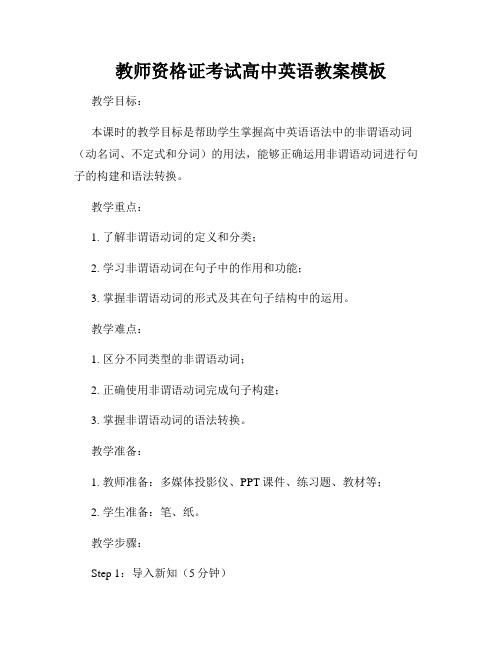
教师资格证考试高中英语教案模板教学目标:本课时的教学目标是帮助学生掌握高中英语语法中的非谓语动词(动名词、不定式和分词)的用法,能够正确运用非谓语动词进行句子的构建和语法转换。
教学重点:1. 了解非谓语动词的定义和分类;2. 学习非谓语动词在句子中的作用和功能;3. 掌握非谓语动词的形式及其在句子结构中的运用。
教学难点:1. 区分不同类型的非谓语动词;2. 正确使用非谓语动词完成句子构建;3. 掌握非谓语动词的语法转换。
教学准备:1. 教师准备:多媒体投影仪、PPT课件、练习题、教材等;2. 学生准备:笔、纸。
教学步骤:Step 1:导入新知(5分钟)1. 热身活动:通过播放一首英文歌曲激发学生学习英语的兴趣。
2. 引入非谓语动词:使用图片或例句引入非谓语动词的概念并给予简要解释。
Step 2:学习非谓语动词(15分钟)1. 分类介绍:介绍不定式、动名词和分词的概念以及它们的分类和形式。
2. 示范语法:用实例句展示非谓语动词在句子中的使用,并归纳规律。
Step 3:非谓语动词的功能与使用(20分钟)1. 配套练习:分发一些练习题,让学生动手填空或改写句子,以加深理解和应用。
2. 合作讨论:学生分组进行合作讨论,分享自己的答案并互相纠错。
Step 4:非谓语动词的语法转换(15分钟)1. 教师讲解:给学生讲解非谓语动词与其他句子成分的转换关系。
2. 操练练习:提供一些练习题,要求学生将给定的句子转换为使用非谓语动词的形式。
Step 5:巩固练习(15分钟)1. 提供一些综合练习题,既包含非谓语动词的使用,也包含其他已学知识点的复习和考察。
2. 学生互相检查和纠错,并及时解答学生的问题。
Step 6:总结和延伸(5分钟)1. 总结:教师对本课时的知识点进行总结概述,并强调学生需要通过多练习巩固所学内容。
2. 延伸学习:鼓励学生利用课余时间进行更多的非谓语动词练习,以提高运用能力。
教学反思:本节课通过丰富的教学资源和互动环节,能够激发学生的学习兴趣并加深对非谓语动词的理解和运用能力。
关于教师资格证高中英语教案模板
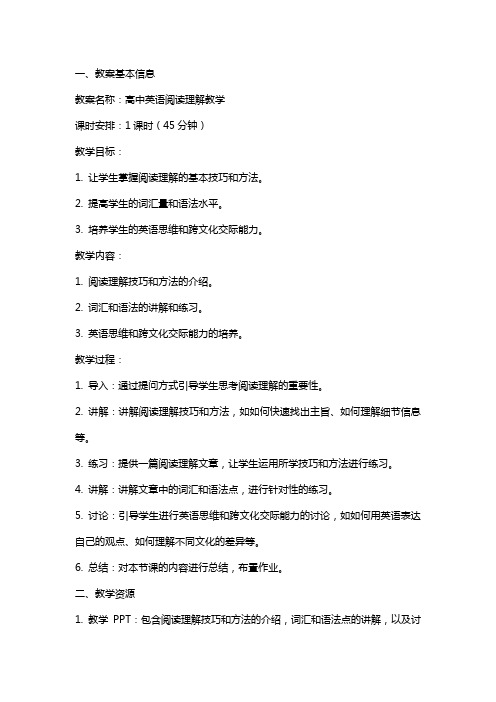
一、教案基本信息教案名称:高中英语阅读理解教学课时安排:1课时(45分钟)教学目标:1. 让学生掌握阅读理解的基本技巧和方法。
2. 提高学生的词汇量和语法水平。
3. 培养学生的英语思维和跨文化交际能力。
教学内容:1. 阅读理解技巧和方法的介绍。
2. 词汇和语法的讲解和练习。
3. 英语思维和跨文化交际能力的培养。
教学过程:1. 导入:通过提问方式引导学生思考阅读理解的重要性。
2. 讲解:讲解阅读理解技巧和方法,如如何快速找出主旨、如何理解细节信息等。
3. 练习:提供一篇阅读理解文章,让学生运用所学技巧和方法进行练习。
4. 讲解:讲解文章中的词汇和语法点,进行针对性的练习。
5. 讨论:引导学生进行英语思维和跨文化交际能力的讨论,如如何用英语表达自己的观点、如何理解不同文化的差异等。
6. 总结:对本节课的内容进行总结,布置作业。
二、教学资源1. 教学PPT:包含阅读理解技巧和方法的介绍,词汇和语法点的讲解,以及讨论话题的引导。
2. 阅读理解文章:提供一篇适合高中生的阅读理解文章,包含不同难度级别的词汇和语法点。
3. 作业:布置相关的阅读理解练习和词汇语法练习。
三、教学评价1. 课堂参与度:观察学生在课堂上的积极参与程度和表现。
2. 阅读理解练习:评估学生在阅读理解练习中的表现,包括对文章主旨的理解、细节信息的捕捉等。
3. 词汇和语法练习:评估学生在词汇和语法练习中的表现,包括对词汇和语法点的理解和运用等。
4. 讨论表现:评估学生在讨论中的表现,包括英语思维和跨文化交际能力的运用等。
四、教学建议1. 在讲解阅读理解技巧和方法时,可以结合具体的阅读理解文章进行讲解,让学生更好地理解和运用。
2. 在讲解词汇和语法点时,可以通过举例和练习的方式进行讲解,让学生更好地理解和运用。
3. 在讨论环节,可以提供一些实际的场景或话题,让学生更好地运用英语思维和跨文化交际能力。
4. 在布置作业时,可以根据学生的水平和需求进行有针对性的布置,让学生更好地巩固和提高。
教资笔试英语高中教案模板
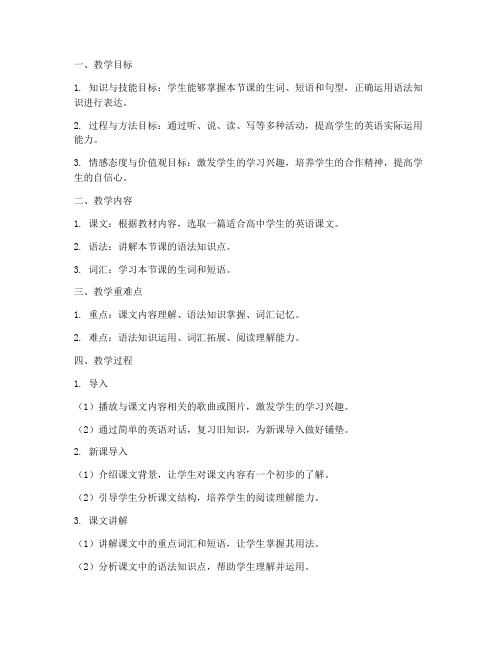
一、教学目标1. 知识与技能目标:学生能够掌握本节课的生词、短语和句型,正确运用语法知识进行表达。
2. 过程与方法目标:通过听、说、读、写等多种活动,提高学生的英语实际运用能力。
3. 情感态度与价值观目标:激发学生的学习兴趣,培养学生的合作精神,提高学生的自信心。
二、教学内容1. 课文:根据教材内容,选取一篇适合高中学生的英语课文。
2. 语法:讲解本节课的语法知识点。
3. 词汇:学习本节课的生词和短语。
三、教学重难点1. 重点:课文内容理解、语法知识掌握、词汇记忆。
2. 难点:语法知识运用、词汇拓展、阅读理解能力。
四、教学过程1. 导入(1)播放与课文内容相关的歌曲或图片,激发学生的学习兴趣。
(2)通过简单的英语对话,复习旧知识,为新课导入做好铺垫。
2. 新课导入(1)介绍课文背景,让学生对课文内容有一个初步的了解。
(2)引导学生分析课文结构,培养学生的阅读理解能力。
3. 课文讲解(1)讲解课文中的重点词汇和短语,让学生掌握其用法。
(2)分析课文中的语法知识点,帮助学生理解并运用。
4. 语法练习(1)通过练习题,巩固学生对语法知识的掌握。
(2)针对学生易错点进行讲解和示范。
5. 词汇拓展(1)通过游戏、卡片等形式,帮助学生记忆生词和短语。
(2)引导学生运用所学词汇进行口头表达。
6. 阅读理解(1)选取与课文内容相关的阅读材料,提高学生的阅读理解能力。
(2)分析阅读材料中的难点,帮助学生理解。
7. 课堂小结(1)总结本节课所学内容,强调重点和难点。
(2)布置课后作业,巩固所学知识。
五、课后作业1. 完成课后练习题,巩固所学语法和词汇。
2. 阅读课文,总结课文大意。
3. 搜集与课文内容相关的资料,进行口头或书面报告。
4. 练习口语表达,运用所学词汇进行情景对话。
六、教学反思1. 教师要关注学生的学习情况,及时调整教学策略。
2. 注重培养学生的合作精神和自主学习能力。
3. 结合学生的实际需求,提高教学效果。
教师资格证考试高中英语教案模板
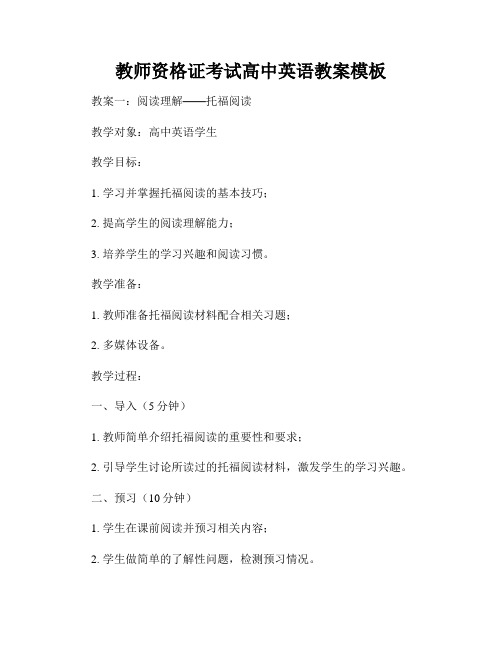
教师资格证考试高中英语教案模板教案一:阅读理解——托福阅读教学对象:高中英语学生教学目标:1. 学习并掌握托福阅读的基本技巧;2. 提高学生的阅读理解能力;3. 培养学生的学习兴趣和阅读习惯。
教学准备:1. 教师准备托福阅读材料配合相关习题;2. 多媒体设备。
教学过程:一、导入(5分钟)1. 教师简单介绍托福阅读的重要性和要求;2. 引导学生讨论所读过的托福阅读材料,激发学生的学习兴趣。
二、预习(10分钟)1. 学生在课前阅读并预习相关内容;2. 学生做简单的了解性问题,检测预习情况。
三、讲解(15分钟)1. 教师通过多媒体展示托福阅读技巧,包括如何快速浏览,如何识别重点信息等;2. 逐个讲解托福阅读题型的解题技巧;3. 引导学生分析和解读范例阅读材料。
四、练习(20分钟)1. 学生在教师指导下进行相关练习,巩固所学技巧;2. 教师及时给予反馈和指导。
五、拓展(10分钟)1. 学生自主阅读一篇与托福阅读相关的文章;2. 学生做思考性问题,展开小组讨论。
六、总结(5分钟)1. 教师总结本节课的教学内容,强调托福阅读的重要性;2. 教师布置相关作业。
教案二:写作——议论文写作教学对象:高中英语学生教学目标:1. 学习并掌握议论文的写作结构和技巧;2. 提高学生的写作能力;3. 培养学生的逻辑思维和表达能力。
教学准备:1. 教师准备议论文写作的相关材料;2. 多媒体设备。
教学过程:一、导入(5分钟)1. 教师引入本节课的写作主题,激发学生的学习兴趣;2. 学生讨论相关话题,分享自己的观点。
二、讲解(20分钟)1. 教师通过多媒体展示议论文的写作结构和技巧;2. 逐步讲解每个段落的写作要点;3. 引导学生分析和解读范例议论文。
三、写作练习(30分钟)1. 学生根据所给话题,自主进行议论文写作练习;2. 教师及时给予反馈和指导。
四、互评交流(15分钟)1. 学生相互交换作文,进行互评;2. 学生小组间展开讨论,共同探讨议论文的优缺点。
教师资格证考试高中英语教学设计模板

教师资格证考试高中英语教学设计模板一、教学设计的背景和目标本次教学设计针对高中英语课程,旨在帮助学生提高英语口语交流能力,并培养他们的听、说、读、写的综合能力。
通过本次课的学习,学生将能够流利地运用所学英语知识与他人进行日常对话,并能够准确理解简单的英文文章。
二、教学内容与重点本次课程将重点教授与日常生活相关的简单对话和阅读理解。
具体包括但不限于以下内容:1. 日常生活中的问候与介绍;2. 购物和点餐的常用表达;3. 询问和提供信息的方式;4. 读懂简单的英文文章。
三、教学方法与步骤1. 创设情境:通过引入有关日常生活的情景,激发学生的学习兴趣,并为后续的教学内容做好铺垫。
2. 听力训练:播放录音或朗读对话,让学生通过听力来熟悉和理解对话内容。
3. 对话模仿:教师示范对话,鼓励学生模仿,并纠正他们的发音和语调。
4. 练习对话:学生在小组中进行对话练习,互相提出问题并给予回答,以强化口语表达能力。
5. 阅读理解:教师呈现简单的英文短文,帮助学生通过理解文章的主旨和关键信息来回答相关问题。
6. 小组合作:学生在小组中共同解答阅读理解练习,并相互讨论和分享答案。
7. 总结与反思:教师对本节课的教学内容进行总结,给予学生积极的反馈和建议,鼓励他们继续努力。
四、教学评估与作业布置1. 口语表达评估:教师对学生的口语表达进行评估,可以以小组对话的形式进行,注意评估学生的语法准确性、流利度和语音语调。
2. 阅读理解评估:布置一篇简单的英文文章,要求学生在限定时间内完成阅读理解题目,并将答案上交。
3. 作业布置:提醒学生复习本节课所学的表达方式和重要词汇,并布置相关的练习题或写作作业。
五、教学资源与素材准备1. 录音机或音频文件:用于播放对话和录制练习。
2. 教材和课件:选用适当的课本和课件,提供对话和阅读材料。
3. 小组活动材料:准备小组活动所需的提示卡片或题目。
六、教学反思与改进本节课教学过程中,学生积极参与互动,并充分运用所学英语知识进行口语表达。
高中英语教资真题教案模板
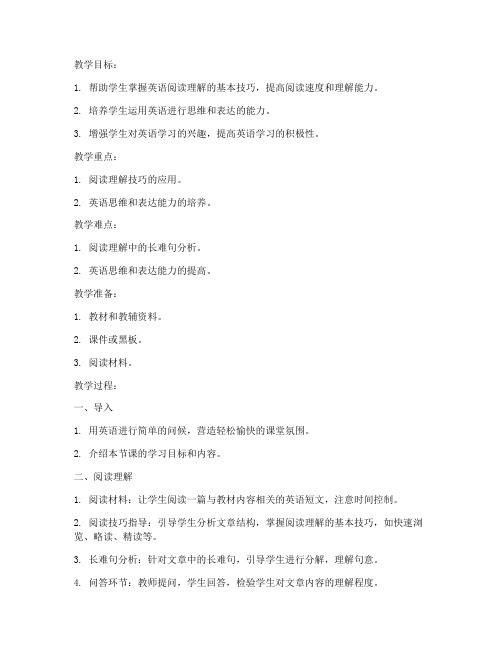
教学目标:1. 帮助学生掌握英语阅读理解的基本技巧,提高阅读速度和理解能力。
2. 培养学生运用英语进行思维和表达的能力。
3. 增强学生对英语学习的兴趣,提高英语学习的积极性。
教学重点:1. 阅读理解技巧的应用。
2. 英语思维和表达能力的培养。
教学难点:1. 阅读理解中的长难句分析。
2. 英语思维和表达能力的提高。
教学准备:1. 教材和教辅资料。
2. 课件或黑板。
3. 阅读材料。
教学过程:一、导入1. 用英语进行简单的问候,营造轻松愉快的课堂氛围。
2. 介绍本节课的学习目标和内容。
二、阅读理解1. 阅读材料:让学生阅读一篇与教材内容相关的英语短文,注意时间控制。
2. 阅读技巧指导:引导学生分析文章结构,掌握阅读理解的基本技巧,如快速浏览、略读、精读等。
3. 长难句分析:针对文章中的长难句,引导学生进行分解,理解句意。
4. 问答环节:教师提问,学生回答,检验学生对文章内容的理解程度。
三、英语思维和表达能力培养1. 思维训练:让学生根据文章内容,用英语进行思考和表达,如复述文章、总结要点等。
2. 口语练习:组织学生进行小组讨论,让学生用英语交流观点,提高口语表达能力。
四、课堂小结1. 回顾本节课的学习内容,强调重点和难点。
2. 布置课后作业,巩固所学知识。
五、教学反思1. 教师根据学生的课堂表现,对教学效果进行反思。
2. 教师针对学生的薄弱环节,调整教学策略,提高教学质量。
教学评价:1. 课堂表现:观察学生在课堂上的参与程度、阅读理解能力、口语表达能力等。
2. 课后作业:检查学生的课后作业完成情况,了解学生对知识的掌握程度。
备注:1. 教师应根据学生的实际情况,灵活调整教学进度和内容。
2. 注重培养学生的英语思维和表达能力,提高学生的综合素质。
教资英语笔试高中教案模板

教学目标:1. 知识与技能目标:学生能够掌握现在进行时的构成、用法和语法规则;能够正确运用现在进行时进行日常交流。
2. 过程与方法目标:通过小组合作、讨论和角色扮演等活动,提高学生的英语听说能力。
3. 情感态度与价值观目标:激发学生学习英语的兴趣,培养学生的团队合作精神。
教学重点:1. 现在进行时的构成:主语 + be 动词的现在式 + 动词的现在分词。
2. 现在进行时的用法:描述正在进行的动作、活动或状态。
教学难点:1. 现在进行时的否定形式和疑问形式。
2. 现在进行时在句子中的运用。
教学过程:一、导入(5分钟)1. 利用多媒体展示图片或视频,引导学生观察图片或视频中的动作,并尝试用英语描述。
2. 提问:同学们,你们知道如何用英语表达正在进行的动作吗?二、新课讲解(15分钟)1. 教师讲解现在进行时的构成:主语 + be 动词的现在式 + 动词的现在分词。
2. 通过例句展示现在进行时的用法,让学生理解其含义。
3. 引导学生分析现在进行时的否定形式和疑问形式,并举例说明。
三、练习巩固(20分钟)1. 小组合作:学生分组,每组完成一份关于现在进行时的练习题,包括选择题、填空题和改错题。
2. 教师巡视指导,解答学生疑问。
四、角色扮演(10分钟)1. 学生根据所学内容,分组进行角色扮演,模拟日常对话。
2. 教师观察并给予评价。
五、总结与作业布置(5分钟)1. 教师总结本节课所学内容,强调现在进行时的构成、用法和语法规则。
2. 布置作业:学生用现在进行时写一篇短文,描述周末的安排。
教学评估:1. 课堂练习:检查学生对现在进行时知识的掌握程度。
2. 角色扮演:观察学生的实际运用能力。
3. 作业:评估学生对现在进行时的运用能力。
教学反思:1. 课堂教学中,注重学生的参与度,提高学生的学习兴趣。
2. 在练习环节,注重学生的合作交流,培养学生的团队合作精神。
3. 在教学过程中,关注学生的个体差异,因材施教。
高中英语教资科教案模板

课时:1课时年级:高中教材:《高中英语》教学目标:1. 理解课文内容,培养学生的阅读理解能力。
2. 提高学生的英语词汇和语法水平。
3. 培养学生的跨文化意识,拓展学生的视野。
教学重点:1. 课文主要内容的理解。
2. 词汇和语法知识的运用。
教学难点:1. 课文内容的理解。
2. 词汇和语法知识的运用。
教学准备:1. 教学课件或黑板。
2. 课文阅读材料。
3. 词汇卡片。
教学过程:一、导入1. 引导学生复习上节课所学内容,为新课的讲解做好铺垫。
2. 通过提问的方式,激发学生的学习兴趣,引入新课。
二、新课导入1. 阅读课文,引导学生理解课文内容。
2. 分析课文结构,总结课文大意。
3. 讲解课文中的重点词汇和语法知识。
三、课文讲解1. 阅读课文,引导学生找出文章主题。
2. 分析文章结构,讲解文章段落大意。
3. 讲解课文中的重点词汇和语法知识,并结合例句进行讲解。
4. 引导学生进行小组讨论,加深对课文内容的理解。
四、巩固练习1. 设计与课文内容相关的练习题,巩固学生对课文的理解。
2. 引导学生运用所学词汇和语法知识进行口语表达。
五、拓展延伸1. 鼓励学生查阅课外资料,了解课文背景知识。
2. 结合课文内容,讨论相关话题,提高学生的跨文化意识。
六、总结1. 回顾本节课所学内容,总结重点词汇和语法知识。
2. 鼓励学生在日常生活中运用所学知识,提高英语水平。
教学反思:本节课通过阅读课文,引导学生理解课文内容,提高学生的阅读理解能力。
在教学过程中,注重词汇和语法知识的讲解,并结合实际进行运用。
同时,通过小组讨论和拓展延伸,培养学生的跨文化意识和综合运用英语的能力。
在教学过程中,应注意以下几点:1. 关注学生的学习需求,针对学生的薄弱环节进行讲解。
2. 创设轻松、愉快的课堂氛围,激发学生的学习兴趣。
3. 注重学生的主体地位,鼓励学生积极参与课堂活动。
4. 结合教材和学情,设计合理的教学环节,提高教学效果。
板书设计:一、课文主题二、课文结构三、重点词汇四、重点语法知识五、拓展延伸课后作业:1. 复习本节课所学内容,巩固所学知识。
- 1、下载文档前请自行甄别文档内容的完整性,平台不提供额外的编辑、内容补充、找答案等附加服务。
- 2、"仅部分预览"的文档,不可在线预览部分如存在完整性等问题,可反馈申请退款(可完整预览的文档不适用该条件!)。
- 3、如文档侵犯您的权益,请联系客服反馈,我们会尽快为您处理(人工客服工作时间:9:00-18:30)。
1. Teaching aims:1. Train the students’ reading ability.2. Enable the students to realize ...3. Stimulate(激发)the students’ interest and ...2. Teaching methods:1. Fast reading to get general idea of the text.2. Careful reading to understand the passage better.3. Teaching procedures(程序):Step1 Lead-inUse some pictures of ... to lead in the topic.Step 2 Pre-reading1. Play a guess game: ...2. Play another guess game: ...Step 3 Predict(预测)1. Ask the students to predict what the reading passage talks about according to the title and illustrations(插图)of passage. The teacher can give some clues by talking about the illustrations:......Step 4 Skimming(略读)1. Let the students skim the whole passage to get the main idea, then evaluate their predictions. During this activity, the teacher should give some guidance(指导)on reading skills.Main idea of the passage:...2. Let the students skim the passage and divide it into different parts to find out the main idea of every part an the topic sentences.Part 1 (paragraph 1...)......Step 5 Careful reading... (问题)Ask the students to scan the second part and complete the chart(图表)with information from the passage.Ask the students to read carefully and finish the following tasks:......Read the statements and decide whether it is true or false and give the reason.(设计一些问题或判断对错等)Knowledge aims1. To listen to and understand the listening materials.2. Students can master the following expressions:...(一些句型)Ability aims1. Enable students to catch and understand the listening materials.2. Develop students’ ability to get special information and take note while listening.3. Get students to learn and use the expressions of ...Emotional aim1. Enable students to know more about ...2. Develop students’ sense of ...Teaching proceduresStep 1 Lead-inPlay a game ...1. Put students into pairs. Give them each two minutes to think of ......(游戏过程)Step 2 Pre-listening1. Tell students they will listen to a dialogue about ...2. Give students some directions and make them predict what the listening text is about.Step 3 While-listening1. Tell students listen to the tape first to get the main idea and decide whether their prediction gist right or not.2. Ask students to listen to the tape again. Let them listen and answer some questions. (Show the questions on the blackboard)3. Students exchange the information and listen to the tape a third time for checking. Let them have the correct answers.Step 4 Post-listening1. Give 2-3 minutes to students to ask questions if they have any.2. Show students the listening text and let them read it aloud.3. Let students read aloud the questions and expressions on the blackboard:...(之前目标里的句型)4. Make sure they will understand and enable to use the, Then let them in Pairs discuss ...5. Get some pairs to act out their dialogue in front of the class.Step 5 Homework1. Make sentences with the expressions in the lesson.2. Surf the internet to find out more information about ...3. 给一篇文章用来讲语法的课堂设计Knowledge objectivesTo learn the use of ... (语法点)Ability objectivesTo use ... (语法)correctly and properly according to the context.Emotional objectives1. To become interested in grammar learning.2. To develop the sense of group cooperationTeaching important pointsGet students to learn and master the new grammar item: ... (语法)Teaching difficult pointsEnable students to learn how to use ... correctly.Teaching proceduresStep 1 Revision1. Check the homework exercises.2. Let students dictate some new words and expressions.Step 2 Discovering useful structures1. Ask students to read through the passage ... , pick out the sentences where ...(语法)are, and then underline ... (语法)2. Let students work in pairs to translate these sentences and try to understand the use of ...3. Have students observe the sentences and draw the conclusion: ...Step 3 Understanding and summarizing1. Ask students to work in pairs to finish the following exercises on how ... are used. (Show the following on the screen)...Step 4 Using structures(Show the following exercises on the screen or give out exercises papers.)Answer the following questions using ......1. Ask students to work in group of four.2. Give them four minutes to finish the work and ask each group to choose the best answers.3. Ask students to choose the best sentences.Step 5 Playing the gameGet into groups and play the game:Step 6 Closing down by a quiz.(Show some exercises on the screen.)Let students finish them within a few minutes, then check the answers with the whole class.Knowledge objectivesBy the end of this lesson the students:1. will have a better understanding of the structure and characteristics of an advertisement.2. will grasp some useful words and expressions to describe a good restaurant such as: ...Ability objectives1. To grasp the use of persuasive sentences.2. To improve the ability of in gathering, analyzing, comparing and making conclusion.Moral objectives1. To improve the students’ learning motivation.2. To make the students become confident.3. To improve their ability of cooperating with each other through discussing. Teaching important and difficult pointsTask-based approach, cooperating approach and communicative approach. Teaching proceduresStep 1 Revision & lead inFirst check the homework of last class.Then let the students swap the homework with each other and discuss in groups of 4, take notes, find out and category the impressive sentences into 5 kinds of information: ...Step 2 Discussing1. Show students 4 pictures of ...2. Ask 3 students to report their work, show them the pictures of ...Step 3 Pre-writing1. Show them the sample ...2. Read the ... and think over what are the characteristics of ... , encourage some students to analyze and tell their opinion.Step 4 While-writing1. Ask students to read the requirements on the text.2. Ask them to write the topic sentence first, and then write at least 6 supporting sentences to ...Step 5 Post-writingLet them swap their passage with each other and recommend 3 most successful ... Step 6 Homework1. Polish students’ writing and write some more aspects of ...Their final work will be modified and selected, then the most successful ones will be put up on the English Corner.2. Review the words and expressions in this unit.Teaching aims1. To know the meaning and usage of the following words: ...To understand some important sentences in the text and know the structure and usage of inversion.2. To master the micro-reading skills through skimming and scanning.3. To know the ability and knowledge ... and develop the ability of getting information from the passage and dealing with the information.Teaching methodsTask-based learning; situational learning; group work learning.The key and difficult points1. To enable the students to get the main idea of the passage, analyze the structure, and get useful information.2. To train the students of micro-reading skills such as skimming and scanning, and develop their ability of reorganizing and transferring information.Teaching processStep 1 Pre-readingQuestion:Step 2 SkimmingQuestions( To explain some words and structures.)Step 3 Detailed readingStep 4 InterviewStep 5 SummaryStep 6 Homework1. Read and practice the dialogue after class fluently.2. Find the useful words and expressions in the passage and do exercises on the textbook following the passage to consolidate them.。
